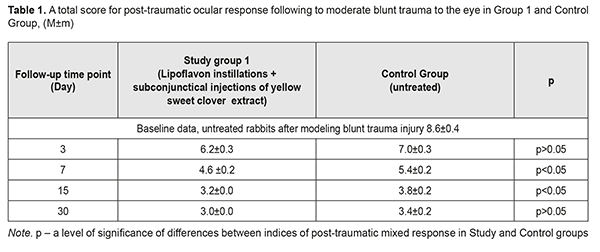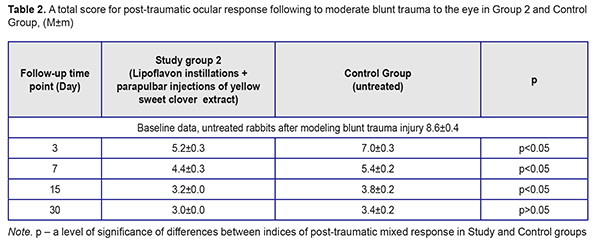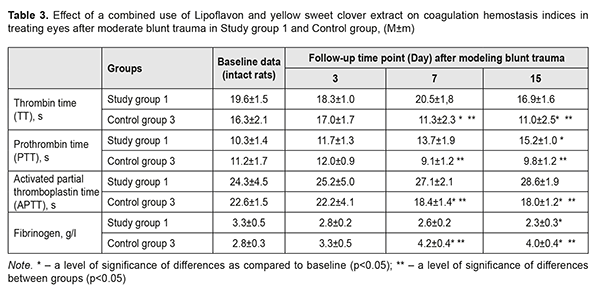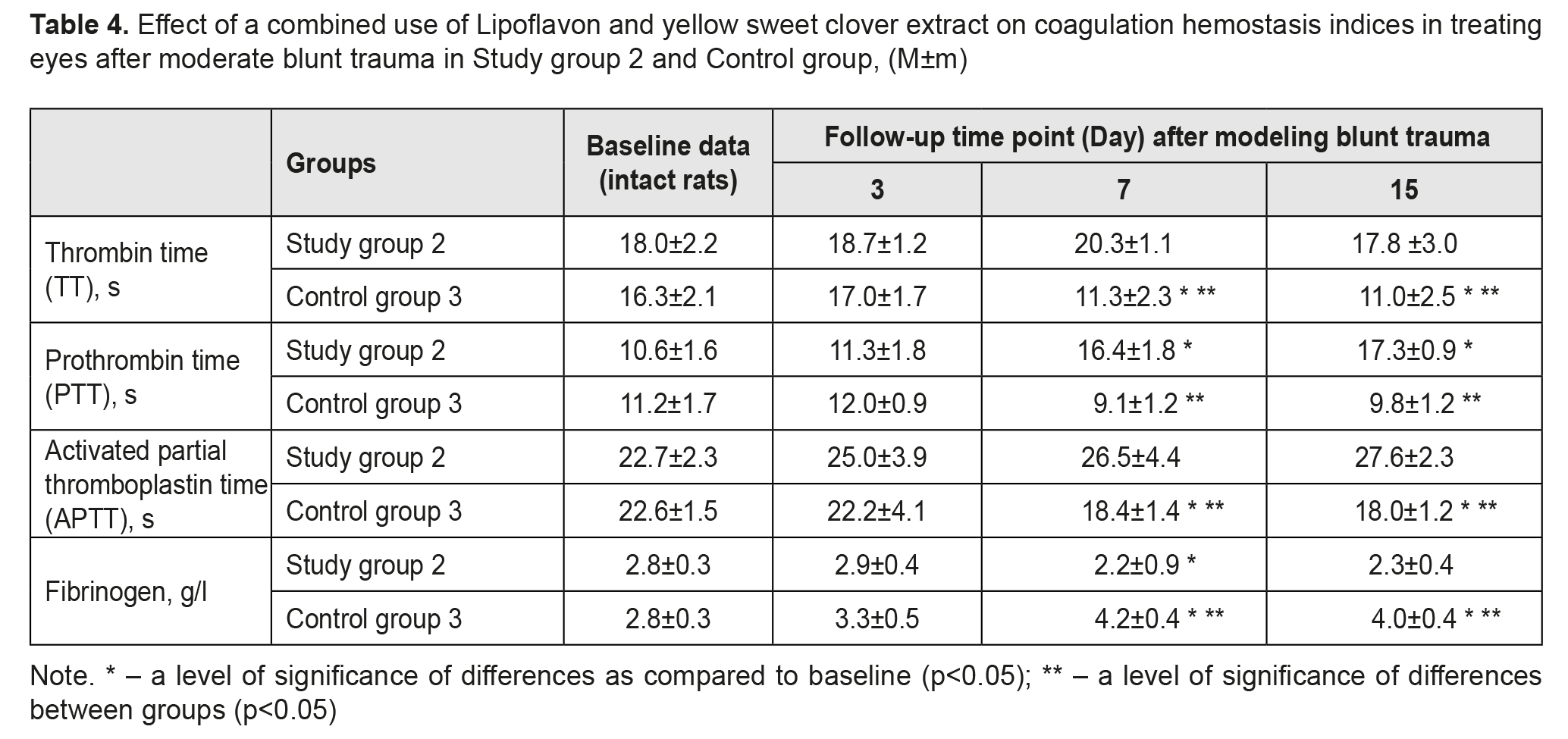J.ophthalmol.(Ukraine).2018;6:59-64.
|
http://doi.org/10.31288/oftalmolzh201865964 Received: 07 September 2018; Published on-line: 31 December 2018 Efficacy of combined liposomal quercetin and yellow sweet clover aqueous extract in moderate blunt trauma to the eye in rabbits O.P. Sotnikova, Dr. Med. Sc., Prof.; N.O. Chudniavtseva, Dr. Med. Sc.; G.S. Fesiunova, Cand. Biol. Sc.; Yu. M. Rodina, Cand. Med. Sc.; T.D.Lotosh, Cand. Biol. Sc.; G.B.Abramova, a researcher; G.M.Tsybuliak, a junior researcher Filatov Institute of Eye Diseases and Tissue Therapy of NAMS of Ukraine; Odessa (Ukraine) E-mail: filatovscience@ukr.net TO CITE THIS ARTICLE: Sotnikova OP, Chudniavtseva NO, Fesiunova GS, Rodina YuM, Lotosh TD, Abramova GB, Tsybuliak GM. Efficacy of combined liposomal quercetin and yellow sweet clover aqueous extract in moderate blunt trauma to the eye in rabbits. J.ophthalmol.(Ukraine).2018;6:59-64. http://doi.org/10.31288/oftalmolzh201865964
Introduction. Despite the numerous experimental and clinical investigations, the development of new rational treatments for blunt trauma to the eye remains a topical issue. Purpose. To study the efficacy of a combined use of liposomal Lipoflavon instillations and periocular injections of a yellow sweet clover aqueous extract for moderate blunt trauma to the eye in experiment. Material and Methods. Moderate blunt trauma (2 to 3 Nm) was accomplished transpalpebrally using a special device in 15 eyes of 30 rabbits. The animals were divided equally into two Study groups and Control Group: Study group 1, instillations of Lipoflavon and subconjunctival injections of a yellow sweet clover aqueous extract; Group 2, instillations of Lipoflavon and parabulbar injections of a yellow sweet clover aqueous extract; Control Group, untreated simulated pathology as controls. A degree of inflammatory response of the eye, a condition of the cornea, and hemorrhages into the anterior chamber were assessed using a scoring system which had been improved by us. Coagulogram characteristics including thrombin time (TT), prothrombin time (PTT), activated partial thromboplastin time (APTT), and fibrinogen were determined. Results. Lipoflavon instillations and periocular injections of a yellow sweet clover aqueous extract for treating the eyes after moderate blunt were proved to have a pronounced therapeutic effect as compared to control, based on the clinical signs of the total post-traumatic response of the eye. The total response of the eye to blunt trauma was slightly decreased in the group receiving parabulbar injections of a yellow sweet clover aqueous extract as compared to the group receiving subconjunctival injections at Days 3 and 7 of the experiment. A combined use of Lipoflavon eye drops and periocular yellow sweet clover injections in treating the eyes after moderate blunt trauma results in changes in coagulation hemostasis indices towards hypocoagulation, which is evidenced by an increase in PTT averagely by 43% and a decrease of the fibrinogen level averagely by 25%. Conclusions. Lipoflavon instillations in combination with periocular yellow sweet clover injections for experimental blunt trauma of moderate severity have a pronounced therapeutic effect comparing to untreated controls and result in changes in coagulation hemostasis indices towards hypocoagulation. Keywords: experimental blunt trauma, Lipoflavon, yellow sweet clover aqueous extract, therapeutic efficacy Introduction Closed globe injury of the eyeball is one of the most pathologically difficult traumas of the eye. Sequellae and complications associated with ocular trauma are one of the major causes of visual incapacity [1]. Among all injuries leading to incapacity, injuries after blunt trauma to the eye ranges from 17 to 22% and is accompanied with a social activity loss of working-age individuals, which determines the high medical and social significance of this pathology [2]. In the modern life, blunt trauma to the eye is characterized by a special severity, which results in vision loss in 24-35% and in eye loss in 3.8-72.2% [3]. Despite numerous experimental and clinical researches, development of new rational treatments for patients with blunt trauma is still of relevance. An important role in the development of blunt trauma-related complications belongs to inflammation which occurs after a traumatic action as well as to hemorrhages in the anterior chamber and in the vitreous body. It was found that hyphema and hemophthalmia developed after blunt trauma of the eyeball in 30-60% and 12-58% of cases, respectively. Various drugs including anti-inflammatory, dissolving and immune-modulating agents are used in treating blunt trauma-related complications. The possibility of using a combined effect simultaneously on several pathogenic foci with a minimal amount of drugs improves treatment outcomes significantly. Complex action drugs, thus, are the best choice for the optimal treatment of ocular trauma [4]. A simultaneous effect of herbs on different ocular structures defines a challenging and relevant problem of stimulating the reparative fibrinolytic processes and inhibiting the inflammatory reaction. In this regard, of a special relevance is a search for effective and available pharmacological substances, a thorough study of the mechanism of their action on the ocular tissues as well as marketing the drugs which improve conservative treatment. A quercetin-containing drug, Lipoflavon, is used in ophthalmology as an anti-inflammatory agent, a stimulator for injured eye tissue regeneration, and an immune corrector. Another component of Lipoflavon is lecithin (natural phosphatidylcholine) which contains polyunsaturated fatty acids, has an anti-oxidant, anti-hypoxic, and membrane-stabilizing properties, enables tissue reparation, and is a transport agent to deliver quercetin to a lesion focus. Lipoflavon eye drops are used for: corneal ulcerations of a traumatic or infectious character; penetrating and non-penetrating wounds; post-traumatic injuries (after cataract extraction etc.); keratitis of various etiologies; and ocular inflammations [5]. A technique of producing an extract from yellow sweet clover was developed and patented by Filatov Institute of Eye Diseases and Tissue Therapy in 2004. The extract was found to contain a complex of biologically active substances. The yellow sweet clover extract was found to have a high anti-aggregatory activity in human blood as well as hypocoagulant characteristics, based on the effect on coagulative hemostasis in experimental animals. The yellow sweet clover extract activates the fibrinolytic system: decreases fibrinogen and, thus, normalizes rheology and microcirculation of blood. In a rabbit hyphema model, the yellow sweet clover extract was found to increase a fibrinolytic potential of tear fluid by normalizing its coagulation activity, which significantly reduces the time of hemorrhage resolution [6, 7, 8]. With this background, studying the pharmacotherapeutic efficacy of a combined use of a liposomal drug, Lipoflafon, and a yellow sweet clover aqueous extract in treating injuries after blunt trauma to the eye using different techniques of periocular injections is relevant and promising. The purpose of the present paper was to study the efficacy of a combined use of liposomal instillations of Lipoflavon and periocular injections of a yellow sweet clover aqueous extract for moderate blunt trauma to the eyeball in experiment. Material and Methods The study was performed in the vivarium of the Filatov Institute of Eye Diseases and Tissue Therapy following the requirements of Bioethics Committee (Protocol No 2 dated 2 July 2015) on 15 Chinchilla rabbits (15eyes), weighted 2.5-3.0 kg, aged 7-8 months, being maintained in separate cages under standard conditions. 15 eyes, one eye in each animal, were injured using a special device to simulate a moderate blunt trauma [9]. The rabbits had been anesthetized previously, a blow was launched transpalpebrally. The animals, after being injured, were divided equally into two Study groups and one Control Group: Study group 1: 5 animals (5 eyes), Lipoflavon instillations and 5 subconjunctival injections of a yellow sweet clover aqueous extract every other day, one injection per day; Group 2: 5 animals (5 eyes), Lipoflavon instillations and 5 parabulbar injections of a yellow sweet clover aqueous extract every other day, one injection per day; Control Group: 5 animals (5 eyes), untreated animals as controls. The periocular injections were made with a dose of 1 ml. Daily Lipoflavon eye drop instillations were performed 4 times a day. Treatment in Study groups started on the following day after the animals were injured. A scoring system was improved by us and used to assess the inflammatory response of the eye, the state of the cornea, and hemorrhages into the anterior chamber with clinical features as follows [10]: Ocular hyperemia: 1 point - physiological norm 2 points – mild hyperemia in the conjunctiva and sclera 3 points – pronounced hyperemia in the conjunctiva and sclera 4 points – strongly-pronounced hyperemia in the conjunctiva and sclera The cornea: 1 point - physiological norm (transparent throughout) 2 points – mild swelling of the cornea 3 points – moderate swelling of the cornea and folds of the Descemet's membrane 4 points – pronounced swelling of the corneal epithelium and stroma, erosion, descemetitis Anterior chamber hemorrhage: 1 point – no hyphema 2 points – hyphema occupying less than one third of the anterior chamber 3 points – hyphema occupying less than two thirds of the anterior chamber 4 points – hyphema totally occupying the anterior chamber To perform a comparative analysis, we used a total score of the three clinical features: post-traumatic ocular hyperemia + a state of the cornea + anterior chamber hemorrhage. The rabbits were followed up from 1 to 30 days. Coagulogram characteristics as follow were determined: thrombin time (TT), prothrombin time (PTT), activated partial thromboplastin time (APTT), and fibrinogen by an optic method using a turbidimetric hemocoagulometer (Solar, Minsk, Belarus) and reagents (SPD «RENAM», Russia) according to standard techniques and following the device recommendations. To assess the quantitative characteristics, we calculated an arithmetic mean value (M) and error of mean (m). Obtained data were statistically processed using STATISTICA software, Microsoft Excel tables; non-parametric methods for data analysis, the Wilcoxon signed-rank test and the Mann-Whitney U test were used [11]. Results and Discussion We analyzed the changes in response of the rabbit’s eye to moderate blunt trauma in Study group 1 (Lipoflavon instillations + subconjunctival injections of a yellow sweet clover aqueous extract) in comparison with untreated controls (Control group). The data are given in Table 1.
The total score of eye response to moderate blunt trauma of all rabbits studied was (8.6±0.4) points. Beginning from Day 3 of treatment, the total score of rabbit eye response to blunt trauma decreased to (6.2±0.3) vs. (7.0±0.3) in controls; post-traumatic ocular hyperemia decreased to (3.6±0.2) points; the state of the cornea was improved, (1.8±0.2) points; hyphema was completely resolved; the anterior chamber aqueous humor was transparent. At Day 7 of treatment the total post-traumatic response score in Study group 1 was (4.6±0.2) with post-traumatic ocular hyperemia ((2.4±0.2) scores), the partially recovered cornea ((1.4±0.2) scores), and the transparent anterior chamber aqueous humor. At Day 15 of treatment, the total post-traumatic response score in Study group 1 was (3.2±0.0): mild post-traumatic ocular hyperemia remained only in one eye ((1.2±0.2) scores); no corneal alterations were observed in the traumatic eyes; all clinical features were normalized. At the same time, the post-traumatic response, equaling (3.8±0.2) scores, remained in controls. At Day 30, the total post-traumatic response score in Control group was (3.4±0.2) The changes in post-traumatic response of the rabbit’s eye after moderate blunt trauma in Study group 2, the rabbits treated with Lipoflavon instillations and parabulbar injections of a yellow sweet clover aqueous extract, were also compared to untreated controls (Control group) (Table 2).
Beginning from Day 3 of treatment, the total post-traumatic response score in Study group 2 was significantly decreased as compared to controls, (5.2±0.3) vs. (7.0±0.3) scores, respectively, with a decreased inflammation reaction of the eye: post-traumatic ocular hyperemia equaled (2.8± 0.2) scores; the state of the cornea was improved and equal to (1.4±0.2) scores; hyphema was completely resolved. At Day 7 of treatment, the total post-traumatic response score in Study group 2 was (4.4±0.3) with (2.2±0.2) scores for post-traumatic ocular hyperemia, (1.2±0.2) scores for the cornea, which was almost recovered, and the transparent anterior chamber aqueous humor. At Day 15 of treatment, the total post-traumatic response score in Study group 2 was (3.2±0.2): mild post-traumatic ocular hyperemia remained only in one eye ((1.2±0.2) scores); no alterations were observed in the cornea of the traumatic eyes; and all clinical features were normalized. At the same time, the post-traumatic response of (3.8±0.2) remained in controls. At Day 30 of treatment, the total post-traumatic response score in Control group was (3.4±0.2). Thus, a combined use of Lipoflafon instillations and periocular injections of a yellow sweet clover aqueous extract in the eyes after moderate blunt trauma contributed to a decrease in the total post-traumatic ocular response at all time points of follow-up regardless of the injection method. A comparative assessment of outcomes of subconjunctival and parabulbar injections of a yellow sweet clover aqueous extract in combimnation with Lipoflavon instillations revealed that, at Days 3 and 7, a decrease in the total post-traumatic ocular response when performing parabulbar injections was somewhat greater than that when a yellow sweet clover aqueous extract was administered using subconjunctival injections. Afterwards, we studied the effect of a combined use of Lipoflavon instillations and subconjunctival/parabulbar injections of a yellow sweet clover aqueous extract on coagulation hemostasis indices in the rabbits with moderate blunt trauma, based on coagulation test findings and in comparison with controls. Significant alterations in coagulation hemostasis towards hypercoagulation were observed in Control group. At Day 7 after blunt trauma modeling, TT (the last stage of blood clotting) was significantly reduced by 31% as compared to baseline values and remained at the same level at Day 14. The APTT test (internal coagulation mechanism) revealed a significantly reduced time, by 19%, at Day 7 and 14 as compared to baseline. The PTT test (external coagulation mechanism) showed no significant changes throughout the experiment. The fibrinogen level increased by 50% at Day 7 after blunt trauma as compared to baseline and remained at the same level at Day 14 (Table 3).
At Day 14 of treatment, PTT (external coagulation mechanism) was significantly increased by 48% and fibrinogen was significantly decreased by 30% in Study group 1 (Lipoflavon + subconjunctival injections) as compared to baseline data in this group. Comparison of findings of Control group (untreated rabbits with blunt trauma) with Study group 1 (Lipoflavon + subconjunctival injections) at Days 7 and 14 showed: TT was decreased by 45% and 37%, respectively; PTT was decreased by 44%; APTT was decreased by 32% and 37%, respectively; and the fibrinogen level was increased by 39% and 26%, respectively. Table 4 demonstrates data on the changes in coagulogram values for Study group 2 (Lipoflavon + parabulbar injections) compared to untreated controls (Control group 3). At Day 14 of treatment, PTT (external coagulation mechanism) was significantly increased by 39% in Study group 2 (Lipoflavon + parabulbar injections) as compared to baseline data in this group. The fibrinogen level decreased by 21% at Day 7; and the same tendency was at Day 14. Comparison of findings of Control group (untreated rabbits with blunt trauma) with Study group 2 (Lipoflavon + parabulbar injections) at Days 7 and 14 showed: TT was decreased by 44% and 28%, respectively; PTT was decreased by 45% and 43%, respectively; APTT was decreased by 31% and 28%, respectively; and the fibrinogen level was increased by 38% and 42%, respectively.
Conclusions Firstly, Lipoflavon instillations in combination with periocular yellow sweet clover injections for experimental blunt trauma of moderate severity have a pronounced therapeutic effect comparing to untreated controls. At Days 3 and 7, the total post-traumatic ocular response was somewhat greater decreased when performing parabulbar injections than that when a yellow sweet clover aqueous extract was administered using subconjunctival injections. Secondly, a combined use of Lipoflavon eye drops and periocular yellow sweet clover injections in treating moderate blunt trauma of the eyeball results in changes in coagulation hemostasis indices towards hypocoagulation, which is evidenced by an increase in PTT averagely by 43% and a decrease of the fibrinogen level averagely by 25%.
References 1.Verigo EN, Gundorova RA, Susaykova MS, Kudinova NG. [Specifics of Urgent Care of Victims of Emergency Situations with Ophthalmic Trauma]. Meditsina katastrof. 2009;4:15-18. Russian. 2.Krasnovid TA. [Successes and failures in rendering urgent medical aid for ocular trauma in Ukraine]. Problems of ecological and medical genetics and clinical immunology: a collection of papers]. Kyiv, Lugansk; 2001. 4(106):15-21. Russian. 3.Blagun NV, Jia Ming. [Specialities of a clinical course, diagnostics and treatment of concussion hyphemas]. Ukrainskii naukovo-medychnyi molodizhnyi zhurnal. Spec. issue. 2011;1:13-14. Ukrainian. 4.Verigo EN, Kuznetsova IA, Romanova IYu. [Conservative therapy and rehabilitation of patients with ocular injuries]. Vestn Oftalmol. 2002;118(2):34-7. Russian. 5.Pasyechnikova NV, Gorshkova RA. [Clinical and biochemical rationale for using a Lipoflavon drug in patients with age-related cataract after cataract extraction and implantation of peroxidation products]. Ukrainskii med. almanakh. 2006;9(1):2014-18. Russian. 6.Sotnikova OP, Fesiunova GS, Abramova GS, Lotosh TD, Sokolova BN, Saldan VI, Ivanov VI. [A useful model patent 3544, Ukraine, MPK 7А61К35/78. A technique for producing aqueous extract of yellow sweet clover]. No 20040504004; Appl. 26 May 2004; Publ. 15 November 2004; Bul. No11. Ukrainian. 7.Sotnikova OP, Fesiunova GS, Lotosh TD. [Experimental studies on anticoagulative фтв fibrinolytic properties of yellow sweet clover aqueous extract]. Odeskii medychnyi zhurnal. 2005;3(89):39-42. Ukrainian. 8.Fesiunova GS. [Effect of yellow sweet clover extract on the course of experimental hyphema]. Oftalmol Zh. 2007;3:55-60. Russian. 9.Rodina YuM, Chudniavtseva NO. [A useful model patent 64593 А Ukraine, 7 А61В3/18. A device for modeling blunt ocular trauma of various severity]. No 2003076482; Appl. 11 July 2003; Publ. 16 February 2004, Bul. No 2. 10.Logai IM, Leus NF, Georgiev DD et al. [Comparative study on the efficacy of anti-inflammatory agents on a model of post-operative inflammation]. Oftalmol Zh. 2001;3:85-92. Russian. 11.Stanton A. Glantz. [Primer of biostatistics. Translated from English. Danilov YuA, the Translator]. M.:Praktika;1999:455. Russian.
|




